 |
||
|
||
| ||
Day 0. Intel's Projects in China and Not Only There
The first Intel Developer Forum (IDF) this year started on April 17, 2007, in Beijing, the capital of People's Republic of China. We try to cover IDF events in the USA and Russia on the regular basis on our web site. But this time the spring American forum did not take place for the first time in many years, so many key events and announcements will be made at IDF in Beijing. Our correspondent joined the Russian delegation there. As it has become a tradition for the last several years, the official IDF - two days in Beijing (April 17 and 18 - it's the first major IDF in China for the whole history of its existence) were preceded by Day 0. On that day the leading experts from Intel shared some "secrets" about promising R&D projects (the corporation is usually reluctant to reveal them) with analysts and journalists. At the same time, an outlook of the engineers working in the leading semiconductor corporation over the future of the industry can throw light on many things.  Day 0 for analysts and press was opened by Justin Rattner, Intel CTO. He stressed that Intel earned a lot of awards from such magazines and communities as Nature, Scientific American, Technology Review, IEEE and many others for the past several years. And market success contributes to healthy conservatism, denial of risky undertakings, resistance to changes. In these conditions Intel R&D departments should heat the imagination of the management with risky undertakings — in full accord with Andrew Grove's "Only the Paranoid Survive". Intel Research Centers work on high-risk innovative projects, which bring Intel architectural and technological leadership. The corporation unites efforts of many research groups all over the world, including academic science, and creates preferable conditions for work in the field of technologies. As a result, innovative products for the market are born. In particular, Intel has three laboratories in universities of Washington, Berkeley, and Carnegie Mellon. The company has joint research projects with DARPA, UCSB, and Tsinghua University in China. For example, much is invested into silicon photonics. Mr. Rattner reminded us that some yesterday's research projects became today's platforms on the market — vPro, Centrino Duo, Viiv.  But many projects shown on this slide are still actively researched. For example, some Digital Health methods are researched in China. Ethnographic research is used to create products for local markets. For example, the famous "Chinese PC". Research in the field of industrial standards, conducted by Intel together with governments and organizations in many countries, plays an important role here. Some near future technologies are shown on the slide. Memory and data storage devices, wireless communications, new platforms, power efficiency, Tera-scale computing — these are only a few Intel's key research projects. The new requirements are a 10-fold reduction in power and performance growth.
Intel in ChinaSome Intel's research projects were presented by heads of local South Asian subdivisions of Intel. Mr. Wen Hann Wang, Vice President, Software and Solutions Group, Intel Asia Pacific, presented Intel China R&D overview. Intel research center in China was established in 2005 near Shanghai on the grounds of Intel Software department created in 1993.  It was initially responsible for local outsourcing, but then this center became involved in technologies for the local market. Later on, the center started participating in the global R&D program of Intel. For example, Intel iPAT — Intel Platform Management Solution for local cafes, classes, local keyboard, etc. A number of Intel projects in China is published on this slide. These are compilers and tools, system software, mobility products, performance optimization, complete mobile platform design, see the slide, etc. Intel actively cooperates with Chinese government and the educational system for students and local research groups. Intel China cooperates with MII to create local opportunities with UEFI BIOS and Framework.  Mr. John Du, Intel China Research Center CEO, went on with the topic of Intel China specifics. Intel Research Center in China was established in 1998, it employs over 80 employees.  One of its missions is Tera-Scale Computing. 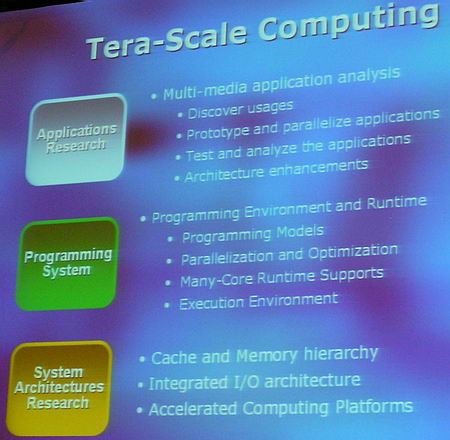 It includes not only architectural aspects of future systems and multimedia applications, but also analysis of programming languages — which language is better for multi-threaded computing. This center also researches evolution of mobile communications. Forum guests were given some examples of research projects from this Center (see the slides). They are Speculative Parallel Threading Research — developing compilers, which can parallel some computing processes. A three-fold performance gain was obtained after optimizations. Research in the field of system architecture: Tera-scale cache, memory, and IO system. 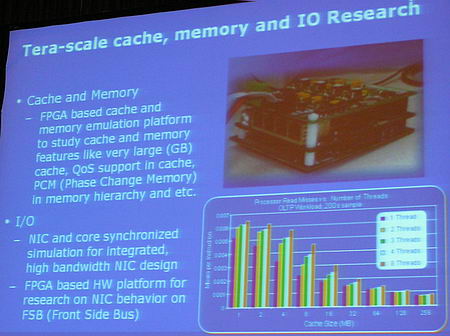 Mobile Broadband — coexistence of several data transfer system, multi radio, multi users.  One of very interesting projects (it was also demonstrated at IDF) is object recognition in a video clip, for example, identification of football players on a playing-field during a TV broadcast. 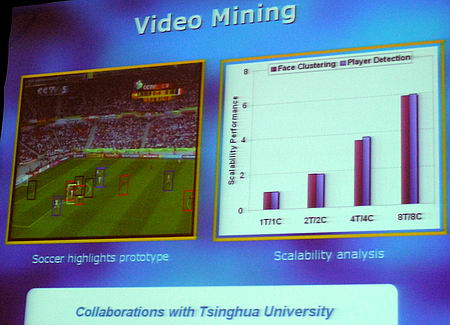 The program identifies players of each team and the ball, it identifies each of the players personally (by his number and face), traces paths of each player and the ball, it can even detect a goal and offside. Recognition quality depends much on video resolution. In case of the standard quality of analog TV broadcast, recognition infallibility in the current version of the program reaches 80-90%. Recognition speed depends much on PC performance. Acceptable real-time recognition requires a dual-CPU server based on quad-core processors from Intel.  Intel Research Center in China cooperates with Chinese government, organizes programs in educational institutions, including integration into the educational program of China. In this respect, Intel's presence in China is similar to what the corporation does in Russia and other countries. The third local reporter, Mr. Tan Wee Theng, noted that Intel's investments to China are probably the richest investments of the corporation outside the USA. Over 7000 Intel employees are working here in 60 towns of continental China. Manufacturing facilities are established in Shanghai, Chendgu and Dalian. 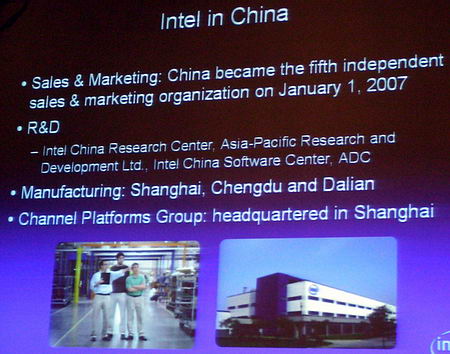 Intel has been working in China for 22 years already, and its presence share is growing together with Chinese economy. Intel has evidently made a significant contribution to the national economy of the country and supported the national IT industry. Intel cooperates with the government and collaborates on the academic and educational levels. 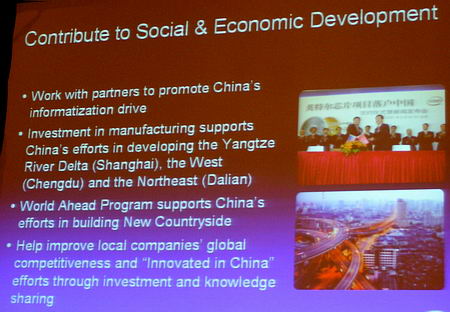 Intel has trained 790 000 Chinese teacher by 2006! Next year Intel will give 10000 PCs to educational institutions in China.
Reconfigurable multi-radioKevin Kahn, Director of Intel Communication Technology Lab, continued the R&D topic. He spoke about research projects of the corporation in the field of multi-radio for mobile platforms. 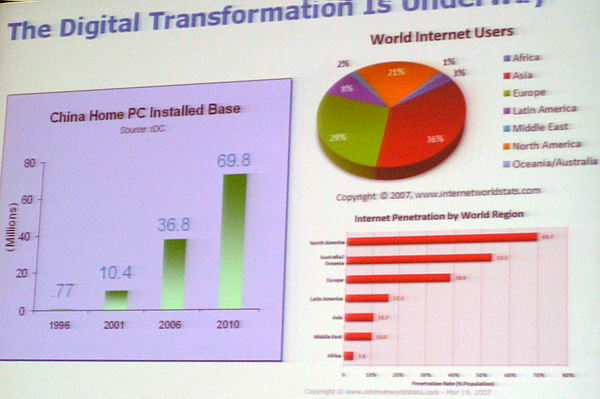 Having noted the inevitable change brought by mobility in our lifestyle, Mr. Kahn stresses that Intel does a lot of research in this field, employing some help of the Chinese department. Ease of use, omnipresence, reliability, security — these are the key categories of new communication products. Several radios operating simultaneously in a single location in close or even the same band — it often happens even now (phone, Bluetooth, WiFi, etc), and the situation will grow more complex. Engineers must provide their compatibility and hassle-free simultaneous operation. Future platforms are expected to have more than six radio channels working simultaneously, see the slide. It's expected already in 2009. 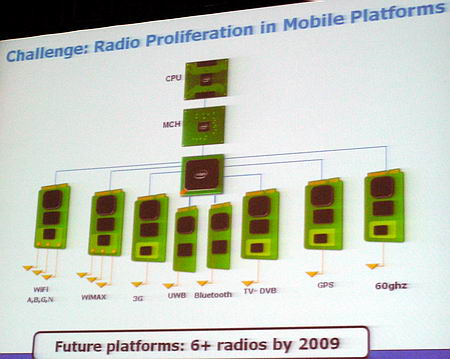 Intel develops complex multi-antenna systems to solve these problems. 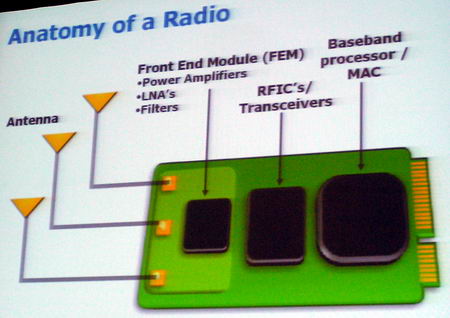 They consist of a FrontEnd module with power amplifiers, a Low-Noise amplifier, and filters. The medium section of such a radio contains only RFIC (Radio Frequency Integrater Circuit). The end section contains a MAC processor. A complex antenna is an important component of such a system.  This research project includes designing a proper form and configuration of an antenna. It's especially critical for PDAs and notebooks. These antennas must be working simultaneously in future platforms. A dynamically reconfigurable antenna is one of solutions to this problem. 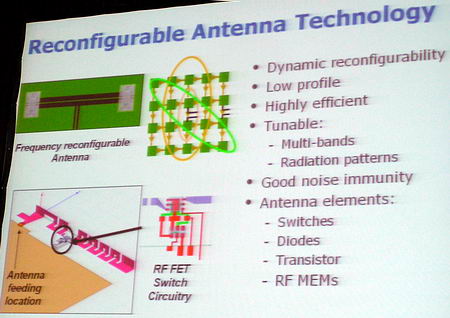 Fragments of an antenna are activated or disabled depending on a frequency. A multi-band antenna covers few bands of interest unlike the usual broadband antenna. A narrow-band antenna demonstrates less noise. So engineers can get better results by choosing an appropriate antenna band. The concept and sample of a reconfigurable antenna were one of the key demonstrations at IDF showcase. The second issue here is the improved on-die radio integration and its flexibility. 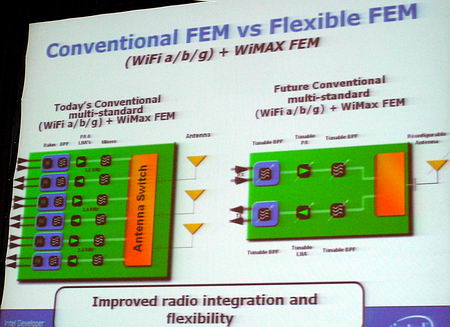 More compact implementation of a radio unit owing to the flexible FEM architecture, Wi-Fi and WiMAX united. Kevin Kahn demonstrated a prototype of the module with these features. The module was quite compact (3×3 mm), so it was hardly visible between reporter's fingers. 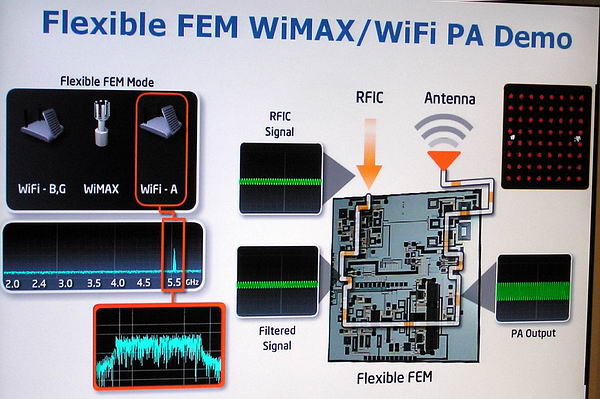 It was also available at the showcase - you could examine it with a microscope. Intel progressed in silicon radio not long ago. The corporation used to have a 90 nm integrated radio solution, as well as 2×2 MIMO Radio launched in 2006. The upgrade to thinner process technologies promises a number of advantages.  Radio-to-radio co-existence issues are also limited by MAC. There is interference between Wi-Fi 2.4 GHz and, for example, the broadcast band 2.5 GHz. And we need simultaneous operation without interferences. 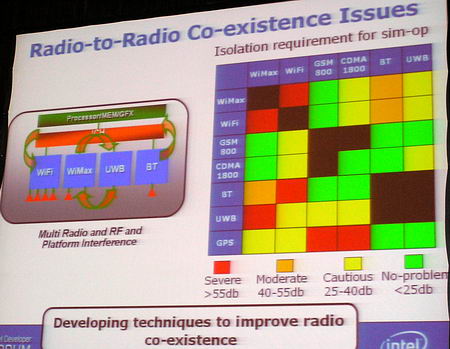 The situation is improved by more accurate control (who and when goes on the air) owing to more accurate band switching. 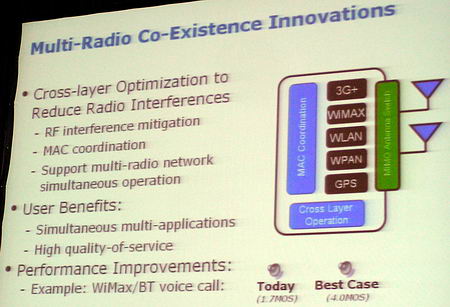 Here are the innovations: Cross-layer optimization reduces radio interference, MIMO antenna is switchable. This technology demonstrates a significant improvement in service quality. Mr. Kahn also noted that the 60 GHz band would be the next radio band for users. In particular, many governments allocate most of this band as license-free, which makes it very popular. But there is a problem here - you need a pointed signal because of the high frequency. And antennas are usually more uniform. That is new narrow-band antennas are needed. But this is a very interesting band, and much has to be done here.
Serial ATA 3.0 and ONFIKnut Grimsrud, Director of Storage Architecture, Intel, shared some information about the nearest future of Serial ATA and ONFI interfaces.  Serial ATA 2.6 specifications were released in March, 2007, and are available on the official web site. Several new revisions concern a compact SATA connector for notebooks, a micro-SATA connector for 1.8" storage drives, NCQ improvements for fall/shock sensor, as well as NCQ priorities for improved responsiveness. Mini multi-lane is added for high-density arrays. Serial ATA 3.0 development is underway - transfer rates will be doubled to 6 Gbps. Completion of SATA 3.0 specifications is expected in the second half of 2007. However, the practical upgrade from 3 Gbps to 6 Gbps will not be as simple as it was with the 1.5-3 Gbps. So even though real transfer rates will not reach 6 Gbps soon, this upgrade must be prepared beforehand. Besides, there exist such devices as port-multipliers and port-aggregators, where 6 Gbps rates will be used earlier. ONFI 1.0 specifications were published in December, 2006 (see www.onfi.org). It's a new interface for flash memory (Open NAND Flash Interface). There used to be no standard for various memory vendors, different manufacturers supplied different controllers. It was sometimes problematic for a controller to support different memory types. And now 52 companies have joined ONFI 1.0. This standard defines common timings, electricals, protocol, pin-out, package, command-set, etc (see the slide). A memory module uses the protocol to inform a host about the device, memory capacity, etc. It's done with the help of an ID number assigned to each type. 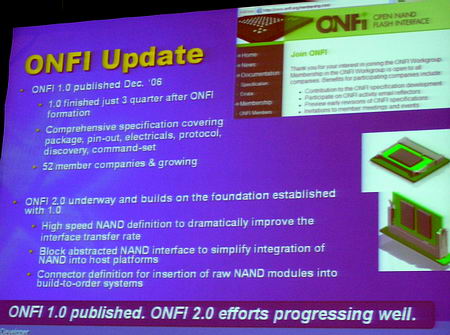 The next generation of ONFI 2.0 is under development now and is based on Version 1.0. You can see their differences on the slide above. It defines three main points — quad speed, Block abstraction NAND interface, connectors and modules — similar to DIMM modules. It will contribute to system unification for end manufacturers/integrators. Samsung is actively negotiating its participation in ONFI, but the Korean company still did not join the standard officially, although they expressed their interest. For example, the CE-ATA interface for CD storage drives is also developed by this group. But in Knut's opinion, CE-ATA will not cross ONFI, so they are developed as absolutely independent interfaces. Even though devices from both segments may have similar applications. In particular, IDF showcase demonstrated the first optical slim drives for notebooks and compact PCs with Serial ATA interface. 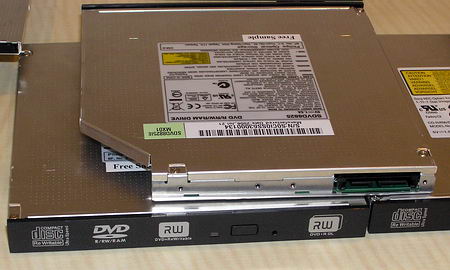 Instead of the standard SATA connector with a long multi-pin power section, they use a short mini-SATA connector with a very short power section (see the photo, on the left). 
Write a comment below. No registration needed!
|
Platform · Video · Multimedia · Mobile · Other || About us & Privacy policy · Twitter · Facebook Copyright © Byrds Research & Publishing, Ltd., 1997–2011. All rights reserved. |